I wasn't sure what to expect when I was planning my visit to Haworth, in the Worth Valley, home of the Brontë sisters. I kept my expectations low, dreaming only of the moors that surrounded this place. My traveling companion was another Zoë!
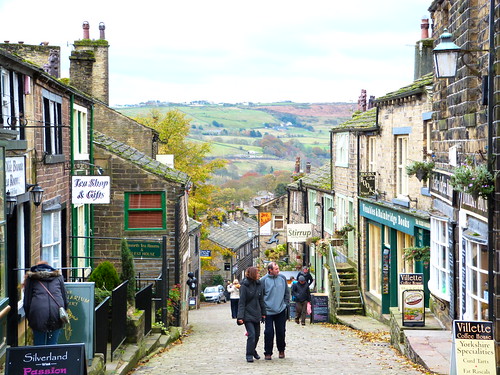
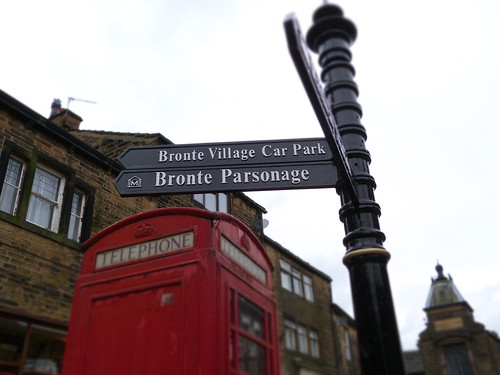
The village of Haworth itself, capitalises on the legacy of the sisters, the last of whom, Charlotte (1816-55), died in 1855. There are Brontë B&Bs, tea rooms, holiday homes, taxi cabs... and so on. There was an excess of gift shops (and old-fashioned sweet shops) selling bunting, hand made jewellery and crafts and Cath Kidston, and those shabby-chic-vintage-oh-remember-the-war! type trinkets that glorify the era of that tired old slogan "Keep Calm and Carry On". These are typically aimed towards the American and Japanese tourists, who make up the majority of visitors ever year. (The village attracts around 75,000 tourists a year, this peaked in the 1970s when it was 250,000 per year!)
The old apothecary where Branwell Brontë (1817-48) purchased the fatal laudanum that he was to die from an overdose of is now run by Rose & Co., a successful British traditional skin-care company based in Haworth. We did spend the best part of an hour oogling the indulgent beauty treats and admiring the shop's collection of vintage beauty packaging, on display below the original glass fronted counter. Many of the shops in the village maintain a "cultivated quaintness", but for me, that's a by-product, I'm not so bothered by it as the locals are entitled to make money to pay their bills.

The famous iron sign that hangs outside the Parsonage, was designed in the 1940s by Mr Mitchell, one of the first curators of the Brontë Parsonage Museum.

"Everything fits into, and is in harmony with, the idea of a country paronage, possessed by people of very moderate means." (Elizabeth Gaskell, novelist and biographer of Charlotte, commenting on the parsonage in a letter to a friend)

The Parsonage is situated by the church and graveyard. In the Brontë's time, the average life expectancy in the village was 25. This influx of bodies into the overcrowded graveyard in turn poisoned the village's water system. It was their father, Patrick Brontë who planted the trees which now surround the house, to accelerate the decomposition of the bodies laid there. Its a sobering thought, the Brontë's truly were surrounded by the apparition of death throughout their lives.

This bronze statue of the Brontë sisters by Jocelyn Horner is in the Heather Garden of the Parsonage, you see it as you pass through to the gift shop (which is particularly well stocked by the way)
We had dinner on the first night in the Old White Lion, founded in the 18th century. Our meal was in the Gimmerton Room which gave me a twinge of excitement! The interior is delightly welcoming and modern, without being contemporary.
The next day before a failed trip to the moors, after seeing the Parsonage, we ate in the quirky café Cobbles and Clay. The menu was extensive, the soups and cakes delicious, and everything is marked as being gluten free, or whether or not its suitable for vegetarians and vegans.
On the morning of our departure we had a baked potato (some honest Northen grub!) in the unpretencious Villette tearooms, having spent the best part of the morning strolling up and down the main street of Haworth, we took ourselves and the books we purchased in Venables and Bainbridge Books, to the 10 The Coffee House, where I had the most divine hot chocolate and homemade biscotti. The hot chocolate I was told was a secret recipe, alas, so I must try and experiment myself. 10 also functions as a B&B, with its refreshing elegant period interior its certainly something I would consider on my next inevitable visit.
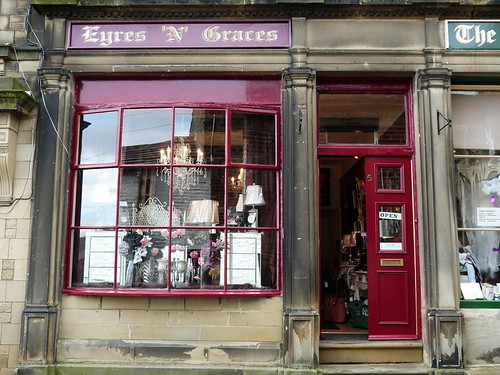
The shop owners of Haworth village owe a pun or two to the village's famous daughters.
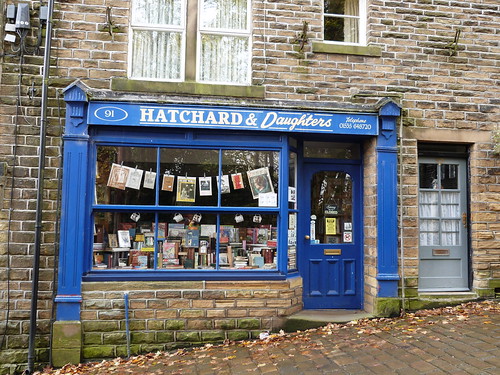

This charming bookshop had an especially inviting window display, but alas it was closed. Haworth experiences a tourist decline in the winter so some of the shops only open on certain days. I really fancied getting that mug!


Village politics


The unique nature of the village means there are a lot of twee homewares, curiosity shops selling "Yorkshire relics" and posters for "wartime balls".
You weren't allowed to take pictures inside the house, and I wouldn't have done it justice anyway, but you can view some images in this flickr set here, or get a virtual tour on the offical website.
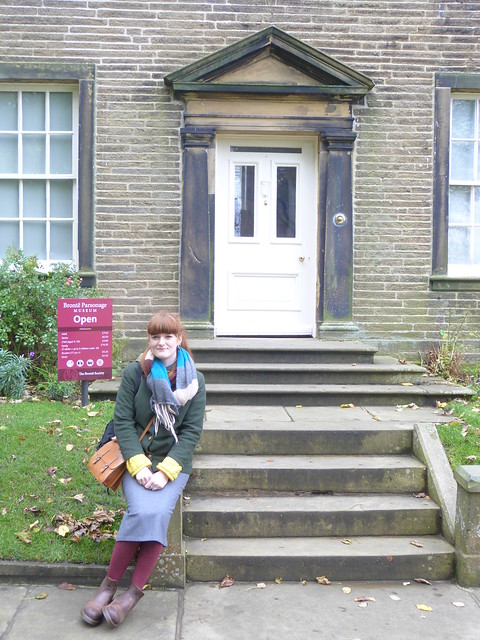
Token photo of me in front of the Parsonage entrance
It was chilling to stand in the doorway of the sitting room, where the three sisters sat around the table and penned their novels. To look upon the sofa where Emily drew her last breath, in denial of her illness until the end. To think of Charlotte pacing this room, alone, for eight years after her siblings deaths. When you're in the upstairs rooms, looking at Charlotte's pint sized dress and wedding bonnet, you might hear the chime of the clock on the stairs, which Rev. Patrick Brontë would set every night before ascending the stairs to his bedroom, after calling upon his daughters to tell them to get along to bed!
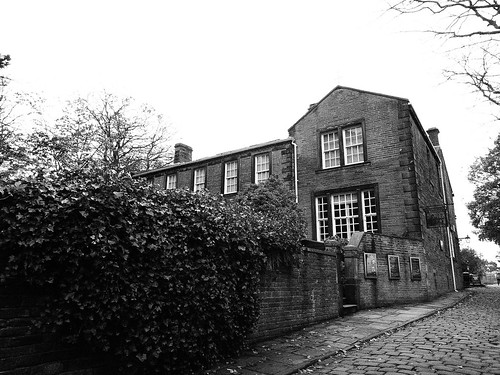
A little and a lone green lane
That opened on a common wide;
A distant, dreamy, dim blue chain
Of mountains circling every side. (Emily Brontë)
The museum is independently run, changes its exhibitions frequently and the Parsonage guidebook was wonderfully informative, as well as being great value. £7.50 for the guide and a guide to the Brontëana exhibit, which is at the end of the house tour. There's all manner of memorabili relating to the family. Scraps of their dresses, handwritten letters, a mourning locket containing Charlottes hair, the famous family juvenilia: those mininature books created about the fictional Gondal when they were children, and on a more sombre note, funerary cards and a sketch by Branwell depicting the spectre of death by his bed, waiting to steal him away, the last known work of his, death did catch up with him only months later.
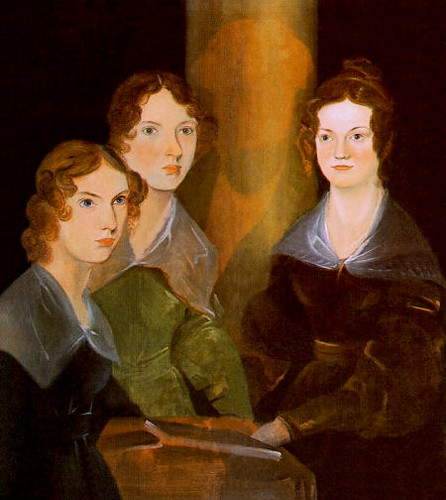
Portrait of Anne, Emily and Charlotte by Branwell, now on display in the National Gallery
A reproduction of the famous portrait by Branwell of his sisters looks upon you as you make your way up the stairs. I was lucky enough to see the original in the National Portrait Gallery before my trip up North. It was found by the second wife of Charlotte's husband, folded on top of a wardrobe.

After my visit I feel invigorated. Clichéd as it may be, having walked the well trodden cobbles that the sisters once walked, I feel a deeper connection with their writing. Somethings changed. I felt the same wind in my hair, the same rain on my skin, the same biting cold. Charlotte spoke of her sadness in walking the moors after her sisters deaths. Emily was in the landscape all around her. Everything was changed utterly. Over 150 years have passed, the world is changed, I had to look harder, and undeniably I was seeing it through rose tinted glasses, but when I closed my eyes I could feel the other worldly mood that hung over that village. My visit shook me up and brought me to the realisation that I don't know half as much as I want to! The sisters were talented artists, writers, craftswomen and knew about maintaining domestic comforts, as was expected of women of their rank.

The headstone from the 1992 film adaption of Wuthering Heights. A toungue in cheek piece of memorabilia also on display in the museum. My favourite adaption!
I plan to join the Brontë Society and on my return to Haworth, whenever that may be, and walk to Top Withens (the inspiration for Wuthering Heights) and Ponden Kirk (Penistone Crags).
Lets not forget that Sylvia Plath's grave at Heptonstall, is close by, as Maeve helpfully informed me!
If you find the idea of Haworth compelling read these three articles, come to your own conclusions. Keep the magic of fantasy alive, or make the pilgrimage? You decide.
Life on Moors (New York Times)
Mad about the Brontes (Jolien Janzing)
The Brontës are alive and unwell in Haworth (Sam Jordison)
The Bronte Parsonage blog is updated regularly.
We stayed in a rather eclectic B&B called Ye Sleeping House, which was a bit overwhelming but an experience in itself:


wow I must add this to my list of places to visit x
ReplyDeleteWhat a wonderful place! Just another addition to my "must go there" list.
ReplyDeleteI told you how long I was waited on this post and look how long it's taken for me to comment! Absolutely ADORED this blog post. The pictures are just so wonderful. I have such a soft spot for this part of the world - the Brontes, but also Plath and Hughes in 1956/57 spent a lot of time here. Such barren, ugly landscapes - but so beautiful too.
ReplyDeleteI'm wondering how you're getting on with The Madwoman in the Attic? When you come up next, it would be great to discuss the essays with you. Particularly that one I referenced before about Christina Rossetti and the Inward Pose. Nice "silence" connotations there, I think selfishly! ;) Would be great to talk about Jane Eyre as well!